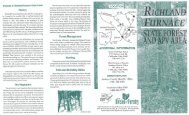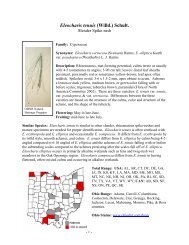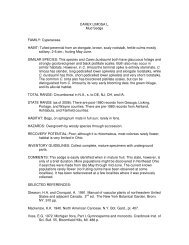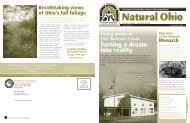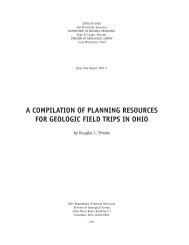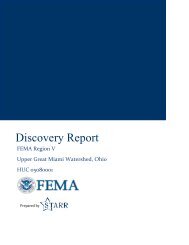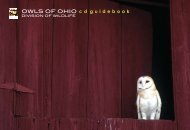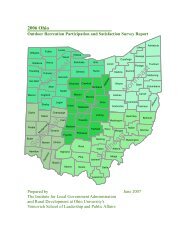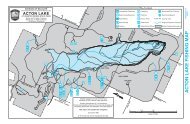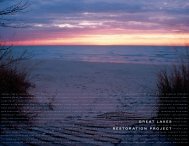special • lake erie • issue - Ohio Department of Natural Resources
special • lake erie • issue - Ohio Department of Natural Resources
special • lake erie • issue - Ohio Department of Natural Resources
You also want an ePaper? Increase the reach of your titles
YUMPU automatically turns print PDFs into web optimized ePapers that Google loves.
Great egret<br />
Black-crowned night heron<br />
areas. Green herons usually nest in isolated pairs in dense<br />
shrubbery or small trees near water.<br />
More difficult to find and observe are yellow-crowned and<br />
black-crowned night-herons. As their name implies they are<br />
nocturnal, spending their day roosting in trees. Other herons<br />
that can be found in <strong>Ohio</strong> include little blue and tri-colored<br />
herons. Besides the great egret, other egrets include cattle<br />
and snowy egrets. Difficult to encounter are the bitterns (least<br />
bittern and American bittern). These birds are very secretive<br />
and highly camouflaged to help conceal their frames in dense<br />
marsh grass.<br />
Wading<br />
Green heron<br />
Birds<br />
Viewing Opportunities<br />
Herons and egrets are great subjects to watch for both<br />
beginner and exp<strong>erie</strong>nced birders. Their size, abundance, and<br />
interesting behaviors will provide many hours <strong>of</strong> enjoyable<br />
viewing.<br />
Look for herons and egrets stalking prey along urban and<br />
rural ponds, stream banks, and shallow areas <strong>of</strong> inland <strong>lake</strong>s.<br />
Along Lake Erie where they are very common, look for herons<br />
and egrets in coastal marshes, as well as in ditches along roadsides<br />
such as State Route 2 in Ottawa and Lucas counties. Some<br />
<strong>of</strong> the wetland wildlife areas managed by the Division <strong>of</strong> Wildlife<br />
that provide excellent viewing opportunities include Big Island<br />
(Marion County), Grand River (Trumbull County), Killbuck<br />
Marsh (Wayne and Holmes counties), Magee Marsh (Ottawa<br />
County), Metzger Marsh (Lucas County), Pickerel Creek<br />
(Sandusky County), and Spring Valley (Greene County).<br />
If you are patient and watch closely you will notice that<br />
different species have different hunting styles. Some lie in wait<br />
for unsuspecting prey to come within reach. Others are more<br />
active and may stir up the muddy bottom to scare up some<br />
aquatic morsel.<br />
Because <strong>of</strong> their sensitivity to people during the breeding<br />
season, most nesting occurs in areas far from humans where<br />
disturbance is minimal. Forty percent <strong>of</strong> all nesting herons and<br />
egrets in the Great Lakes region nest on West Sister Island in<br />
Lake Erie. Public access<br />
is not permitted on this<br />
designated federal wilderness<br />
area, but viewing can<br />
be done from a boat using<br />
a high-powered viewing<br />
scope.<br />
Cattle egret<br />
SPRING 2005 WILD OHIO 5



